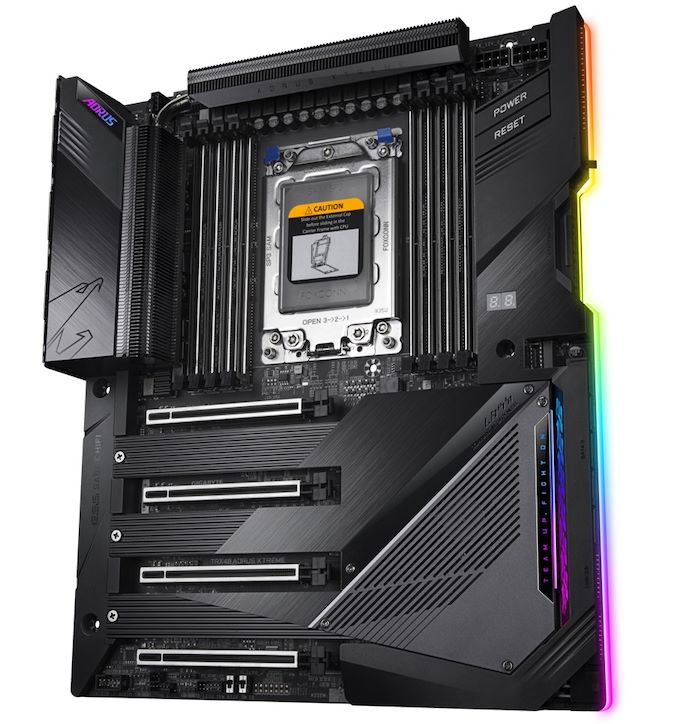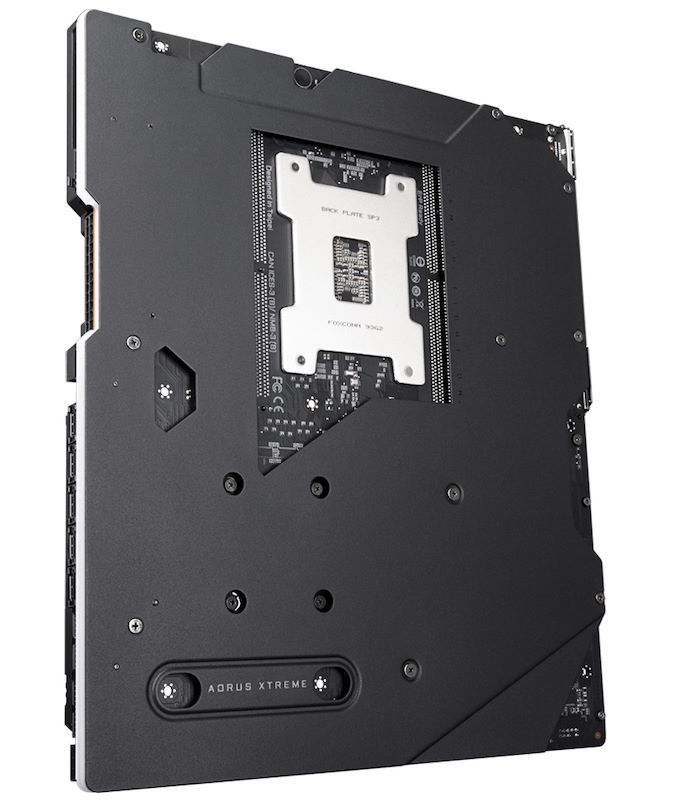The AMD TRX40 Motherboard Overview: 12 New Motherboards Analyzed
by Gavin Bonshor on November 28, 2019 9:00 AM EST- Posted in
- Motherboards
- AMD
- MSI
- Gigabyte
- ASRock
- Asus
- TRX40
- Threadripper 3000
- Castle Peak
GIGABYTE TRX40 Aorus Xtreme
To bolster the release of AMD's Threadripper 3000 series, GIGABYTE has unveiled the largest stack of all the vendors with a total of four new models. Three of GIGABYTE's TRX40 product stack flies the Aorus flag which is its gaming brand, with one model aimed more towards the professional user and content creators.
Starting with GIGABYTE's flagship TRX40 model, the GIGABYTE TRX40 Aorus Xtreme, it shows the potential of what to expect from AMD's new TRX40 chipset. The core feature set is impressive with an Intel X550-AT2 10 GbE dual-port Ethernet controller, an Intel AX200 Wi-Fi 6 wireless interface, and a total of four PCIe 4.0 x4 M.2 slots designed for super-fast NVMe PCIe 4.0 storage devices. Also bundled with the TRX40 Aorus Xtreme is an Aorus Gen4 AIC adaptor card which supports up to four 2 TB M.2 SSDs while benefiting from the bandwidth of PCIe 4.0.
The GIGABYTE TRX40 Aorus Xtreme is an XL-ATX motherboard and has a very unique and distinct look to it with a full coating of black metallic thermal reactive armor which covers the majority of the PCB. Integrated into the design is RGB LED lighting which is incorporated into the top of the rear panel cover, the right-hand side of the TRX40 chipset which features active cooling, and along the right edge of the board. A two-digit LED debug is moulded into the armor to the right of the memory slots, while a power and reset switch is placed just above. Focusing on memory support, the GIGABYTE TRX40 Aorus Xtreme has eight slots which are capable of supporting DDR4-4400 and up to 256 GB in quad-channel mode.
Underneath the rear panel cover and the large heatsink is the monolithic 16-phase power delivery which is controlled by the high-end Infineon XDPE132G5C true 16-phase PWM controller, with sixteen Infineon TDA21472 70 A power stages. This is similar to the design that we saw on the GIGABYTE X570 Aorus Xtreme model and in our testing, it proved to be one of the best and most efficient designs so far. The TRX40 Aorus Xtreme also has four full-length PCIe 4.0 slots which operate at x16/x8/x16/x8. For storage, there are four PCIe 4.0 x4 M.2 slots with its own M.2 heatsink, and a total of ten SATA ports; eight from the TRX40 chipset with RAID 0, 1, 10 support, and two SATA ports from an ASMedia SATA controller.
On the rear of the XL-ATX PCB is a full cover backplate which not only adds extra structural reinforcement to the rear but it also undoubtedly adds extra weight to the motherboard itself. Looking at the board from the rear allows us to see the right-angled 24-pin ATX motherboard power input, which is designed to make cable management look even cleaner. The GIGABYTE TRX40 Aorus Xtreme also includes an OC PEG power connector, an Aorus Gen4 AIC adaptor, and temperature sensor headers for the more extreme users. For cooling, there are seven 4-pin headers in total with one for a CPU fan, one for a water pump, and five for chassis fans.
On the rear panel is seven USB 3.1 G2 Type-A, and one USB 3.1 G2 Type-C port, which is a marked improvement on USB connectivity over the previous TR3 X399 models. To the left is a Clear CMOS button with a Q-Flash Plus button, with a pair of Intel AX200 Wi-Fi 6 antenna connectors and two 10 GbE ports powered by an Intel X550-AT2 10 GbE controller. For the onboard audio, there are two Realtek ALC4050H HD audio codecs with one paired up with a Realtek ALC1220 which powers the five 3.5 mm audio jacks and S/PDIF optical output on the rear, and another for the front panel audio which includes an ESS Sabre 9218 DAC.
The GIGABYTE TRX40 Aorus Xtreme is undoubtedly one of the flagship models on AMD's new Threadripper 3000 sTRX4 socket with a very high-end feature set, and very competent true 16-phase power delivery for the CPU. It's blend premium componentry and elegant stylings aren't going to come without a heavy hit to the wallet, with the GIGABYTE TRX40 Aorus Xtreme expected to cost $849.













109 Comments
View All Comments
PopinFRESH007 - Sunday, December 29, 2019 - link
PCIe is a serial point to point topology so each link or "lane" is independent (ignoring things like PCIe switches). This is different to the legacy PCI bus which is a shared parallel bus which would behave as you've described.Dionysos1234 - Thursday, November 28, 2019 - link
Any information on what memory is supported? ECC?Llawehtdliub - Saturday, November 30, 2019 - link
Yes ECC is supportedVatharian - Thursday, November 28, 2019 - link
Has anyone from ASUS actually thought even for a second about the PCI-Express slots placement? Using dual GPUs, until converted truly to single slot with water cooling, blocks most of the slots. In my case I'd need 4 or 5 slots, which leaves ROG Zenith II Extreme from their linup. And ASRock Creator. As much as I hate Gigabyte I must admit their Aorus line has sensible layouts, and MSI's are mixed bag.nevcairiel - Thursday, November 28, 2019 - link
These boards are clearly not designed for Dual GPU purposes, but instead actually offer quite some space for the primary GPU (3 slots is mandatory for many high-end air cooled cards these days), and additional slots for other 1 slot cards.eek2121 - Friday, November 29, 2019 - link
Nearly every board I looked at in the article has spacing for multiple GPUs.eek2121 - Friday, November 29, 2019 - link
I noticed you said 3 slots. I have a high end GPU, it takes 2 slots. The 3rd slot is extremely far away from the 2nd slot and could comfortably fit a GPU. Factor in the width of an m.2 drive when looking at the pictures above and you'll realize you are mistaken (many of the boards have m.2 slots in between, That is all the space you need for air cooling a GPU, since most high end hardware only takes up 2 slots, the 3rd 'slot' is actually where an M.2 drive would sit, and the real third slot is below it, leaving plenty of space for cooling fan air circulation).Spunjji - Friday, November 29, 2019 - link
Serious question - are dual-GPUs even used these days?I know they're out for gaming, but I don't know the state of play regarding GPU compute.
Bccc1 - Friday, November 29, 2019 - link
For GPU rendering (e.g. Redshift, Octane and VRay Next) dual GPUs are quite common and even quad GPUs can be used quite efficiently.eek2121 - Friday, November 29, 2019 - link
I don't kow about the "blocking most of the slots" terminology. On my X399 board, only 1 slot is blocked (and technically you still could put a card in that slot, I actually had a low profile x4 card next to my GPU without any heat issues). On many X570 boards, spacing is such that no slots are blocked. In both cases, there are single slot GPUs, just not high end ones. As you've stated, using a custom loop allows for even high end GPUs to use only 1 slot.